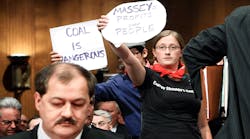Former Massey Energy CEO Donald Blankenship was sentenced to a year in prison for conspiracy to willfully violate mine health and safety standards. He was investigated after 29 workers died during an explosion at Massey’s Upper Big Branch mine on April 5, 2010.
After a two-month trial in U.S. District Court in Charleston, W.Va., a jury convicted Blankenship in 2015 of a misdemeanor charge of conspiracy, one of three criminal counts against him. The jury found that Blankenship, from about Jan. 1, 2008 through about April 9, 2010, conspired to commit and cause “routine, willful violations” of mandatory federal mine safety and health standards at the Upper Big Branch mine. The jury found Blankenship not guilty of two felony charges: lying to investigators and of securities fraud.
The federal grand jury indictment issued in 2014 alleged that Blankenship was part of a conspiracy to impede and hinder federal mine safety officials from carrying out their duties at Upper Big Branch by providing advance warning of federal mine safety inspection activities, so their underground operations could conceal and cover up safety violations that they routinely committed. According to an investigation by MSHA, these safety violations contributed to the fatal explosion.
There are some CEOs who privately think that OSHA, EPA or MSHA violations are part of the cost of doing business. Blankenship does more than think it; he has stated it publicly. He called occupational safety and health violations “a normal part of the mining process” during an interview with West Virginia's Metronews radio network.
Blankenship now is out of prison and writing letters. He recently announced that his attorneys were filing a Supreme Court cert petition. The petition argues that the trial court and the 4th Circuit Court of Appeals made two errors that warrant a remand or reversal of his case.
“The first error was that the trial judge gave instructions to the jury that my failure to prevent others from violating mine safety laws meant I was committing a crime myself,” said Blankenship in a letter addressed to the “public at large.”
“The second error,” he continues, “was that the judge denied my attorneys any opportunity to cross-examine a lead prosecution witness about 42 mine citation exhibits and about statements the witness alleged were made by me.”
Blankenship also claims that “MSHA cut the airflow in half [for the miners] shortly before the explosion,” insinuating that the agency charged with protecting miners and enforcing mine safety laws was to blame for the explosion.
Blankenship also sent a letter to President Donald Trump, in which he thanks the president “for being a great supporter of coal miner jobs. No doubt you want to be even more supportive of coal miner safety.” He then goes on to attack efforts by Sen. Joe Manchen (D-WV) to increase the criminal liability for coal mine supervisors.
Blankenship claims that he and President Trump “share relentless and false attacks on our reputation by the liberal media. The attacks on me have been relentless since 1985 when the miners at a group of mines I supervised chose to decertify their union membership. I am hopeful that in considering this request to improve coal miner safety, you will put aside the media's false claims about me and help me expose the truth of what happened at the Upper Big Branch (UBB) coal mine in West Virginia on April 5, 2010.”
“Fake news” aside, let’s look at real facts: In the 5 years before the explosion, MSHA issued a total of 1,342 safety violations for the mine, proposing $1.89 million in fines. Massey contested the citations and managed to keep the cases tied up in court by taking advantage of loopholes in MSHA regulations and procedures. In the 2 months before the disaster, the mine was evacuated three times for methane. Yet despite this long-time pattern of violations, the mine continued to operate because Massey used MSHA’s own policies and appeals process to keep the mine from being placed on a pattern of violations, which would have triggered tougher enforcement.
Here’s something Blankenship didn’t mention in his letter to President Trump. In 2005, he sent a letter to the superintendents of his deep mines, which said: “If any of you have been asked … to do anything other than run coal … you need to ignore them and run coal. This memo is necessary only because we seem not to understand that coal pays the bills.”
There are very few true villains in occupational safety and health. Despite his protests to the contrary, In my mind, Don Blankenship is one of them.

